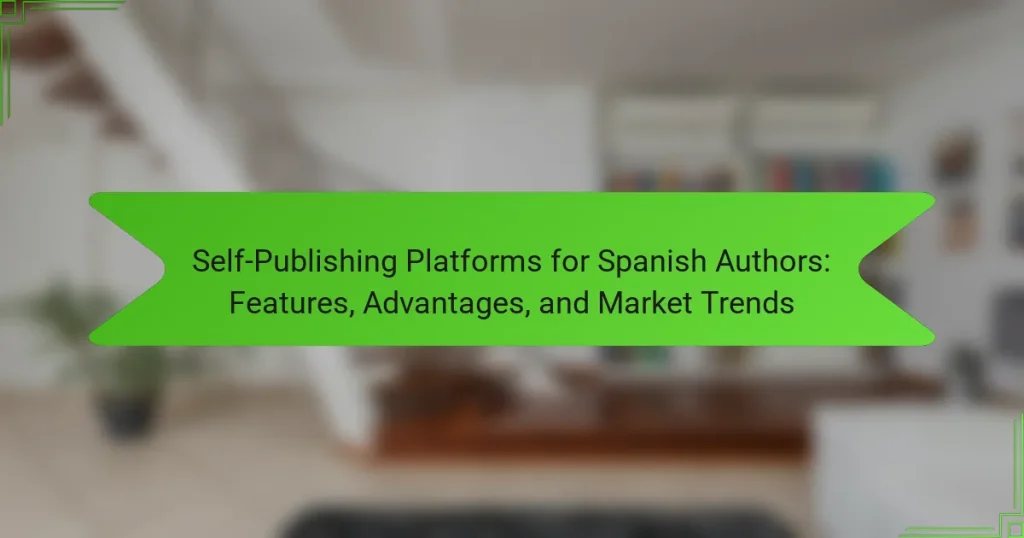Self-publishing platforms empower Spanish authors to retain creative control and earn higher royalties. Key features include user-friendly tools, tailored marketing strategies, and enhanced distribution networks. Current market trends show a growing demand for Spanish-language content, alongside challenges like visibility and competition. Understanding these platforms can help authors effectively navigate the evolving literary landscape.

What are the key features of self-publishing platforms for Spanish authors?
Self-publishing platforms for Spanish authors offer several key features that enhance the publishing experience. These platforms typically provide user-friendly interfaces, allowing authors to easily upload and format their manuscripts. They often include tools for cover design, editing, and marketing, catering specifically to the Spanish-speaking audience. Additionally, many platforms facilitate distribution across various online retailers, increasing visibility and accessibility. The ability to retain a higher percentage of royalties compared to traditional publishing is another significant advantage. Lastly, current market trends show a growing demand for Spanish-language content, making these platforms increasingly relevant.
How do these features enhance the publishing experience?
Self-publishing platforms enhance the publishing experience for Spanish authors by providing user-friendly tools, wider distribution channels, and targeted marketing options. These features streamline the publishing process, allowing authors to focus on content creation. The ability to access analytics helps authors understand their audience better and refine their strategies. Additionally, community support fosters collaboration and networking among authors, enriching their overall experience.
Which platforms offer the most comprehensive tools for authors?
Several platforms offer comprehensive tools for authors, including Amazon Kindle Direct Publishing, Lulu, and Smashwords. These platforms provide user-friendly interfaces, extensive distribution networks, and various formatting options.
Amazon Kindle Direct Publishing allows authors to reach millions of readers and offers robust marketing tools. Lulu provides print-on-demand services and customizable book formats. Smashwords focuses on eBook distribution to multiple retailers, enhancing visibility.
Each platform has unique features that cater to different author needs, making it essential for authors to evaluate which aligns best with their goals.
What role does user interface play in platform effectiveness?
User interface significantly enhances platform effectiveness by improving user experience and accessibility. A well-designed interface facilitates navigation, allowing Spanish authors to efficiently publish and manage their works. Key features include intuitive layouts, clear call-to-action buttons, and responsive design, which collectively reduce barriers to entry. As a result, authors are more likely to engage with the platform, leading to increased publication rates and user satisfaction.

What advantages do self-publishing platforms provide to Spanish authors?
Self-publishing platforms offer Spanish authors greater creative control, higher royalty rates, and access to global markets. These advantages empower authors to reach diverse audiences while retaining ownership of their work. Platforms like Amazon KDP and Smashwords provide user-friendly tools for formatting and distribution, enhancing the publishing process. As a result, Spanish authors can effectively navigate the evolving literary landscape.
How do these platforms empower authors in creative control?
Self-publishing platforms empower authors by offering full creative control over their work. Authors can choose their book’s content, cover design, and pricing, enabling personalized branding. These platforms provide tools for marketing and distribution, allowing authors to reach wider audiences without traditional publishing constraints. Additionally, authors retain rights and royalties, enhancing their financial benefits.
What financial benefits can authors expect from self-publishing?
Authors can expect significant financial benefits from self-publishing, including higher royalty rates and control over pricing. Self-publishing platforms often allow authors to retain up to 70% of royalties, compared to traditional publishing’s average of 10-15%. Additionally, authors can set their prices and adjust them based on market trends, maximizing earnings. With the rise of digital distribution, authors can reach global audiences, further enhancing their revenue potential. The accessibility of self-publishing also enables authors to publish more frequently, increasing their chances of financial success.
How do self-publishing platforms facilitate global reach for Spanish authors?
Self-publishing platforms enable Spanish authors to reach global audiences by providing accessible distribution channels and marketing tools. These platforms allow authors to publish in multiple languages, ensuring wider readership. Features like e-book formats and print-on-demand services enhance visibility. Additionally, analytics tools help authors understand market trends and reader preferences. This global reach fosters cultural exchange and increases opportunities for Spanish literature.

Which market trends are shaping the self-publishing landscape for Spanish authors in 2025?
Market trends in 2025 will significantly influence the self-publishing landscape for Spanish authors. Increasing demand for diverse voices is driving platforms to enhance accessibility and user experience.
Emerging technologies, like AI-driven editing tools, are streamlining the publishing process. These innovations allow authors to focus on creativity while improving the quality of their work.
Social media integration is vital, enabling authors to connect directly with readers and build their brands. This trend fosters community engagement and enhances marketing efforts.
Additionally, the rise of subscription-based models offers authors new revenue streams, allowing them to monetize their work beyond traditional sales.
How is the demand for Spanish-language content evolving?
The demand for Spanish-language content is increasing rapidly due to growing Hispanic populations and cultural interest. Self-publishing platforms are adapting by offering features tailored for Spanish authors, such as bilingual support and targeted marketing tools. These platforms provide advantages like creative control and higher royalty rates, making them appealing in a competitive market. Trends indicate that Spanish authors are leveraging these platforms to reach wider audiences, reflecting a significant shift in content consumption.
What impact does technology have on self-publishing trends?
Technology significantly enhances self-publishing trends for Spanish authors by providing accessible platforms and tools. These platforms offer features like user-friendly interfaces, extensive distribution networks, and marketing support. As a result, authors can reach wider audiences and manage their publishing processes more efficiently. The growth of e-books and print-on-demand services has further democratized publishing, allowing for diverse voices to emerge in the Spanish literary market. Additionally, advancements in analytics enable authors to track reader engagement and tailor their content accordingly, fostering a more personalized reading experience.
How are reader preferences influencing self-publishing strategies?
Reader preferences significantly shape self-publishing strategies by driving platform features and content offerings. Spanish authors increasingly seek user-friendly interfaces, diverse distribution options, and marketing tools tailored to their audiences.
Market trends indicate a growing demand for bilingual content and localized marketing strategies. Platforms that provide analytics and insights into reader behavior enable authors to adapt their works effectively. As a result, self-publishing strategies are evolving to prioritize reader engagement and feedback.
Authors are also leveraging social media integration and community-building features to enhance visibility. These adaptations reflect a shift towards collaborative storytelling, where reader preferences directly influence narrative directions and promotional approaches.

What challenges do Spanish authors face when using self-publishing platforms?
Spanish authors face several challenges when using self-publishing platforms. Limited visibility and competition from established authors hinder their reach. Language barriers can complicate marketing efforts, especially in English-speaking markets. Additionally, many platforms lack adequate support for Spanish-language content, affecting distribution. Authors also struggle with understanding the technical aspects of self-publishing, which can lead to suboptimal results.
How can authors navigate the complexities of marketing their work?
Authors can navigate marketing complexities by leveraging self-publishing platforms tailored for Spanish audiences. These platforms offer features like user-friendly interfaces, extensive distribution networks, and marketing tools. Advantages include greater control over pricing and royalties, as well as direct access to readers. Current market trends indicate a growing demand for Spanish-language content, making it essential for authors to utilize these platforms effectively.
What are the common pitfalls in the self-publishing process?
Common pitfalls in the self-publishing process include lack of proper editing, inadequate marketing strategies, and neglecting cover design. Many authors underestimate the importance of professional editing, which can lead to poor reviews and sales. Additionally, failing to develop a marketing plan often results in limited visibility and audience reach. Cover design plays a crucial role in attracting readers, and a poorly designed cover can deter potential buyers. Understanding these pitfalls can help Spanish authors navigate the self-publishing landscape more effectively.
How does competition within the market affect self-publishing?
Competition within the market significantly influences self-publishing by driving innovation and improving platform features. As more authors opt for self-publishing, platforms enhance their tools to attract users. This includes better distribution options, marketing support, and user-friendly interfaces. Increased competition also leads to more affordable pricing models, benefiting authors financially. Additionally, market trends show a growing demand for bilingual content, prompting platforms to cater specifically to Spanish authors, thus expanding their reach. Ultimately, a competitive landscape fosters a more dynamic and supportive environment for self-publishing.

What unique attributes distinguish popular self-publishing platforms for Spanish authors?
Unique attributes that distinguish popular self-publishing platforms for Spanish authors include language support, cultural relevance, and distribution networks. These platforms often offer tools tailored for Spanish-speaking audiences, such as localized marketing strategies and access to regional bookstores. Additionally, unique features like royalty structures and community engagement options enhance their appeal. Platforms may also provide analytics specific to Spanish-speaking markets, helping authors better understand their readership.
Which platforms offer specialized services for niche genres?
Several platforms specialize in services for Spanish authors, providing tailored features. Notable options include Amazon Kindle Direct Publishing, which offers extensive reach, and Lulu, known for customizable print options. Additionally, Draft2Digital simplifies eBook distribution across multiple retailers. These platforms enhance visibility and accessibility for niche genres within the Spanish-speaking market.
How do regional preferences influence platform selection?
Regional preferences significantly influence platform selection for Spanish authors by aligning with cultural nuances and market demands. Authors often choose platforms that offer localized support, language options, and tailored marketing strategies. For instance, platforms like Amazon Kindle Direct Publishing provide Spanish language interfaces and regionalized promotional tools, enhancing accessibility. Additionally, the popularity of social media in Spanish-speaking countries drives authors to select platforms that integrate smoothly with these networks, facilitating audience engagement and outreach. Ultimately, understanding regional preferences helps authors optimize their publishing strategy and reach their target audience effectively.
What innovative features are emerging in the self-publishing space?
Innovative features in self-publishing for Spanish authors include enhanced digital distribution, AI-driven editing tools, and integrated marketing services. These advancements streamline the publishing process, increase visibility, and cater specifically to the needs of Spanish-speaking markets. AI tools provide personalized feedback, while marketing services help authors reach wider audiences effectively.

What are the best practices for maximizing success on self-publishing platforms?
To maximize success on self-publishing platforms, Spanish authors should focus on understanding the unique features of each platform, optimizing their marketing strategies, and engaging with their target audience. Key practices include selecting the right platform based on distribution options, leveraging social media for promotions, and utilizing data analytics to refine their approach. Additionally, authors should consider the advantages of print-on-demand services and eBook formats to reach diverse readers. Staying updated on market trends can also inform content creation and marketing efforts.
How can authors effectively market their self-published works?
Authors can effectively market their self-published works by leveraging targeted self-publishing platforms that cater to Spanish-speaking audiences. These platforms offer features such as user-friendly interfaces, marketing tools, and distribution networks tailored for Spanish authors.
Utilizing social media and online communities can amplify reach and engagement. Additionally, authors should consider offering promotional discounts or free chapters to attract readers. Engaging with local literary events and book fairs can also enhance visibility and connect with potential readers.
Monitoring market trends is crucial; understanding reader preferences can guide content and marketing strategies. Collaborations with other authors or influencers can further expand audience reach.
What strategies should authors employ to enhance reader engagement?
Authors should utilize interactive content, personalized communication, and community building to enhance reader engagement. Interactive elements like polls or quizzes can captivate audiences. Personalized emails and messages foster a sense of connection. Building a community through social media or forums encourages discussions and loyalty. These strategies significantly boost reader involvement and satisfaction.
How can authors leverage social media to promote their publications?
Authors can effectively use social media to promote their publications by engaging with their audience and sharing valuable content. They should focus on building a personal brand and connecting with readers through platforms like Twitter, Instagram, and Facebook. Regularly posting updates, behind-the-scenes content, and teasers can generate interest. Collaborating with influencers and participating in online communities can further expand their reach. Utilizing targeted ads can also help in reaching specific demographics, enhancing visibility for new releases.




